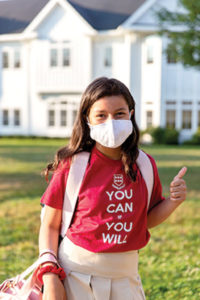By Daintry Zaterka, Fay School

Photo/submitted
Southborough – Back in September, nobody was certain how returning to school during a pandemic would work. The good news is that we have made it through the first half of a very challenging school year. Unfortunately, with projections that the vaccine won’t be available to most of us until mid to late spring, we may have some long, frustrating, and unpredictable months ahead of us yet.
As infection levels rollercoaster, students in many districts are bouncing between in-person, remote, and hybrid learning, and it’s hard to anticipate what form school will take from one week to the next. As children thrive on routine, all this persistent uncertainty can be particularly stressful for them. In a Gallup poll conducted in May of 2020, 29% of parents said that their child was “already experiencing harm” to their emotional or mental health because of social distancing and closures. An additional 14% indicated that their children were approaching their limits and could continue only a little while longer before their mental health suffers.
While struggling with their own pandemic fatigue, parents are seeing the toll this extended experience is taking on children and are looking for ways to ease their stress and anxiety. At Fay, where Lower School students are at school in-person and have been throughout the fall, Head of Lower School Lainie Schuster has been observing the effects of this experience on her students. She shares her advice for parents on nurturing resilience in their children as they help them navigate the next few months.
Keep talking and listening
Even when it seems that there’s nothing new to say about COVID, Lainie notes that making sure that children feel heard in their worries and concerns is essential. She echoes the advice of Fred Rogers, who said, “In times of stress, the best thing we can do for each other is to listen with our ears and our hearts and to be assured that our questions are just as important as our answers.”
Admit that you don’t have all the answers
When kids are chafing at seemingly endless COVID restrictions, it can also be tempting to brush off those persistent queries of, “When is this going to end?” or “Will I be able to see my friends soon?” However, parents don’t need to know all the answers. They can help by listening to the questions and letting kids know that they are not alone in feeling frustrated. “I’ve been getting better at saying, ‘I don’t know the answer to that yet,” says Lainie, “and parents have to be willing to say that too.” Assure them that life will get back to some semblance of normalcy while acknowledging that you don’t know exactly when that is going to happen.
Give flexibility and choices
Kids are desperate for some control in a daily routine governed by restrictions and protocols. Parents can help by giving them more opportunities to make decisions and changes to the family routine when possible. It can be as simple as letting them choose dinner or being more flexible about when chores get done. “It’s about giving kids the chance to make those little decisions, because they’re not so little to kids!” says Lainie.
Model responsibility and positivity
Kids are carefully observing how the adults in their lives handle the stressors of a pandemic, and parents can help their children cope by rededicating themselves to modeling patience, kindness, and good humor under pressure.
Reach out to others
Encourage kids to focus on helping others as a way to channel their frustration into positive action. When Lainie saw some kids volunteering to help customers at her local market get their groceries to the car, it was a reminder that small actions can make a big difference in how we all navigate the next few months. “Reaching out to others can give kids a sense of accomplishment, purpose, and pride,” she adds.
Create time together
Families have been spending a lot of time in the same house, but they’re not necessarily spending it together, points out Lainie, who worries about the rise of isolationist activities like video games. Lainie recently created a serialized podcast of her reading Wilson Rawls’ “Where the Red Fern Grows” for her Fay students and encouraged families to listen to the story together. “Reading as a family is a great way to take an independent activity and use it to bring everyone together,” Lainie says. “Pull out the Parcheesi and Sorry and bring back family game night,” she adds, “because encouraging those social connections that we’re all missing is so important!”
Education – Community Advocate
















